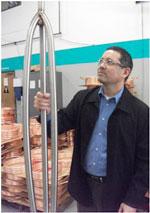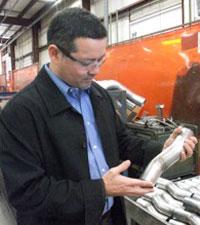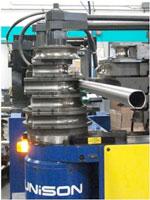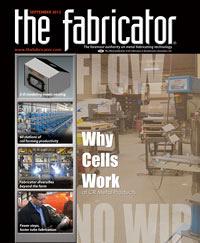- FMA
- The Fabricator
- FABTECH
- Canadian Metalworking
Categories
- Additive Manufacturing
- Aluminum Welding
- Arc Welding
- Assembly and Joining
- Automation and Robotics
- Bending and Forming
- Consumables
- Cutting and Weld Prep
- Electric Vehicles
- En Español
- Finishing
- Hydroforming
- Laser Cutting
- Laser Welding
- Machining
- Manufacturing Software
- Materials Handling
- Metals/Materials
- Oxyfuel Cutting
- Plasma Cutting
- Power Tools
- Punching and Other Holemaking
- Roll Forming
- Safety
- Sawing
- Shearing
- Shop Management
- Testing and Measuring
- Tube and Pipe Fabrication
- Tube and Pipe Production
- Waterjet Cutting
Industry Directory
Webcasts
Podcasts
FAB 40
Advertise
Subscribe
Account Login
Search
Combination bender eliminates multiple setups, welding, grinding
Fabricator trades bend-cut-bend-cut-bend-cut-weld-grind-polish-blend sequence for bend-bend-bend-polish sequence
- By Eric Lundin
- September 7, 2012
- Article
- Tube and Pipe Fabrication

Figure 1: Rafael Nuñez Jr. shows a modern handhold for mass transit. Often described as European styling, this type of design dispenses with straight lines and right angles in favor of flowing curves. In addition to being more aesthetically pleasing than a straight tube, this design provides many more handholds than a single tube.
To say that the management team at SF Tube Inc., Hayward, Calif., is frugal in its spending would be an understatement. The outlook is one of caution, making investments only after careful research. It’s not that the company doesn’t spend money; indeed it does. The company keeps extra machines on hand for redundancy. Also, the management team understands the value in certification and invested the time, effort, and money necessary for ISO 9001:2008, AS9100, and the National Aerospace and Defense Contractors Accreditation Program (Nadcap).
However, SF Tube is thrifty and patient, always on the lookout for the right opportunity. The executives are ever-vigilant, always keeping an eye out for the best value for the dollar. The story of a recent quest for a tubing bender is an example of the company’s careful, thorough nature.
Amassing Mass Transit Manufacturing Experience
When SF Tube’s owner, Rafael Nuñez Sr., delved into the tube bending world, he was an employee of a tube bending and engineering plant that was founded in San Francisco in the 1940s. When he founded SF Tube Inc. in 1987, his new company likewise focused on transportation, but a different area: shipbuilding. While much has changed over the years, the company has been involved in transportation for its entire history. As shipbuilding disappeared from U.S. shores, the company transitioned to heavy trucks in the 1980s, making components for semi manufacturers such as Peterbilt, Kenworth, Mack Western, and International Harvester. As these companies left the West Coast, SF Tube chased business in the mass transit industry, netting contracts for parts for buses and trains (see Figure 1). Transportation is so critical to the company’s success that it recently moved from San Francisco to Hayward, Calif., to be closer to many existing and potential customers.
This isn’t to say that the company is focused only on transportation. In 2000 it had an opportunity to expand its customer base in a big way. When the owner and his son, Rafael Nuñez Jr., were looking for locations in Hayward, they learned that the equipment of another tube fabricator was for sale at auction. Nuñez Jr. went to check out the building and the equipment and, after doing some research, realized that the equipment was just one small part of an extremely valuable find.
The building, soon to be empty, would be a big benefit to SF Tube. Its biggest customer was just four blocks away, which would enable SF Tube to provide much better service for this customer. The equipment would expand the company’s capabilities, allowing it to pursue new opportunities in the short term, such as semiconductors and aerospace. However, these paled in comparison to the knowledge and experience of the company’s employees, who would soon be available for hire. The influx of personnel with backgrounds in lean manufacturing, quality, and engineering, coupled with experience in manufacturing tube and duct for the aerospace industry, would augment that of SF Tube, positioning the company for future growth.
“I arrived with one goal but left with very different goals,” Nuñez Jr. said. “The real value was in the people.”
The original staff of 10, coupled with the newly hired team, put SF Tube on a growth path many manufacturers would envy. Now staffed at 62 people, the company is much bigger, and its customer base is much broader. It has many customers in the defense industry, which is no surprise given the number of defense contractors on the West Coast. Also, the company is in Silicon Valley, so supplying tubular components to clients in the semiconductor industry is a natural fit. SF Tube also serves other industries abundant on the West Coast, such as agriculture, food processing, aerospace, and wine processing, as well as the medical equipment industry, hydraulic tube industry, and the deep-sea exploration niche.
Getting into new markets isn’t as easy as learning to make parts for new clients. In many cases, a certification or accreditation is necessary. Credit goes to the newly acquired staff members, who were instrumental in guiding the company through the long, challenging process of Nadcap certification. Likewise, becoming a Boeing-approved supplier was a considerable hurdle, requiring about five years.
“A lot of hard work went into the certifications,” Nuñez Jr. said.
Bend It, Cut It, Weld It

Figure 2: Bending, cutting, and welding to make a part is a common practice at SF Tube. Rafael Nuñez Jr. shows a typical part, its weld easily visible.
To serve this diverse customer base, the company has an extensive fleet of machines. It has welding stations, mainly for gas tungsten arc welding (GTAW) fusion welds, augmented by gas metal arc welding (GMAW), semiautomatic orbital welding, and induction brazing. It has machining centers, a lathe, an ironworker, a drill press, a hydraulic press, a cold saw, and band saws. It coils copper tubing and provides end forming services—squaring, flaring, beading, expanding, and swaging—and it pulls T’s. All these activities support its main activity: tube and pipe bending. It has semiautomatic benders, CNC benders (networked and linked to a laser inspection system), and a roll bender.
Despite moving forward into new markets with stringent quality requirements, the company continued to protect its financial position by investing in older bending technology.
“We never went the route of buying brand-new equipment, so we had a lot of older benders,” Nuñez Jr. said.
For several reasons, some related to manufacturing processes and some related to business conditions, the staff at SF Tube began to consider modernizing and upgrading its bending operations.
- To make a multiradius component, SF Tube had to use several benders. It would bend short lengths of tube to the appropriate radii and assemble them (see Figure 2). Aside from wasting the material that had to be cut from each bent tube, the process required substantial time for welding, grinding, and polishing each weld. It also consumed quite a bit of floor space.
- It had used all of its available floor space, in part because the company grew during 2009 and 2010, when many fabricators were struggling.
“Manufacturing in the Bay Area was down 70 percent four years ago, but we have grown every year,” Nuñez Jr. said. “This is partly because we make specialized parts, not commoditized parts. We just don’t have a lot of competition.”
- Nuñez Jr. anticipates that the company will continue to grow.
“In terms of the economy, it is definitely picking up,” he continued. “We’re not just seeing growth with new customers, but we’re seeing growth within our existing customer base also. Everything points in the direction of growth. To be able to continue to explore new markets, grow our business, and add processes is critical right now, but if we don’t have the space, we won’t be able to do it.”
The company also plans to add more value-added services to its repertoire.
“Part of our business plan is to add CNC machining centers and sheet metal work,” Nuñez Jr. said.
- Commercial space is more expensive in urban areas than rural areas, and Silicon Valley is an extreme example. Using the existing floor space more efficiently would be a better option than leasing more space.
- The aging bender fleet was a growing cost. The company had the necessary expertise in-house to maintain and repair its fleet of benders, but these activities took up an increasing amount of time and money as the equipment aged. Finally, all of the company’s benders were manually programmed, a time-consuming process. The skilled-worker shortage exacerbated this problem.
“We had no choice to succeed other than through automation,” said Nuñez Jr.

Figure 3: SF Tube found that a single combination bender, one that provides both rotary draw and roll (push) bends, has the productivity of three of the company’s legacy bending machines.
The staff realized that SF needed to take a step forward in technology.
Bender Upgrade
“We were trying to reduce some process steps by performing several processes on one piece of equipment,” Nuñez Jr. said. Another main goal was the battle it was fighting with floor space. Predictions of future growth meant the shortage of free floor space would likely get worse in a hurry.
“After careful consideration, we decided to purchase a new electric CNC bender,” said Nuñez Jr. Its existing benders were fairly simple; each held just one tooling set, so a workpiece with two rotary bends and one roll bend required three setups on three machines. The Breeze series from Unison had the potential to help resolve quite a few challenges (see Figure 3). Equipped with stacked tooling, the machine can make rotary bends in several radii in one setup. The machine also makes roll bends. This is a big advance in productivity and reduction in floor space.
Second, the new machine saves a lot of time.
Making all the bends on a single machine means that the company can dispense with the bend-cut-splice-weld-grind-polish-blend sequence in favor of two steps, bend and polish. Another labor saver is the new bender’s self-leveling feature.
“Using our conventional roll bender required two people: one to operate the machine and a second person to level the tube as it was being run. Sometimes the process needed a third person. The new bender is self-leveling, so it needs just one operator.”
Changing from one bend to another is much quicker than before.
“Setups take less than 5 minutes,” Nuñez Jr. said. “On our legacy equipment, it took up to 45 minutes.”
However, Nuñez Jr. pointed out that the new acquisition came with two challenges. First, the company needed to start recruiting employees with a different skill set.
“It forced us to look for a different level of employee, because the new machine is computer-based,” Nuñez Jr. said.
The company also was cautious about overloading its operators. It already had benders from three manufacturers, which meant its operators had to learn to use three sets of controls. Adding a fourth brand complicated this.
Finally, it was concerned about an adequate training program.
“One of our main challenges is training, and the vendor has been very helpful, doing a tremendous job continuing the dialogue,” Nuñez Jr. said.
After using the new machine, SF Tube noticed a few additional benefits for the company and its staff.
“The energy consumption is approximately one-tenth that of a traditional hydraulic bender,” Nuñez said. This is a big deal in California, where the rate for commercial electricity can be 50 percent higher than in neighboring states.
The staff has noticed that the noise level is favorable, too. Finally, the push technology reduces wear on the wiper die and more so on the pressure die, meaning the tooling lasts longer.
How did all this go over with the company’s management team?
“We’re planning to buy another Unison, one with 3.5-in. capacity,” Nuñez Jr. said.
About the Author

Eric Lundin
2135 Point Blvd
Elgin, IL 60123
815-227-8262
Eric Lundin worked on The Tube & Pipe Journal from 2000 to 2022.
Related Companies
subscribe now

The Fabricator is North America's leading magazine for the metal forming and fabricating industry. The magazine delivers the news, technical articles, and case histories that enable fabricators to do their jobs more efficiently. The Fabricator has served the industry since 1970.
start your free subscription- Stay connected from anywhere

Easily access valuable industry resources now with full access to the digital edition of The Fabricator.

Easily access valuable industry resources now with full access to the digital edition of The Welder.

Easily access valuable industry resources now with full access to the digital edition of The Tube and Pipe Journal.
- Podcasting
- Podcast:
- The Fabricator Podcast
- Published:
- 04/16/2024
- Running Time:
- 63:29
In this episode of The Fabricator Podcast, Caleb Chamberlain, co-founder and CEO of OSH Cut, discusses his company’s...
- Industry Events
16th Annual Safety Conference
- April 30 - May 1, 2024
- Elgin,
Pipe and Tube Conference
- May 21 - 22, 2024
- Omaha, NE
World-Class Roll Forming Workshop
- June 5 - 6, 2024
- Louisville, KY
Advanced Laser Application Workshop
- June 25 - 27, 2024
- Novi, MI































